How To Remove Watercolor Paint
Watercolor painting looks then simple. A well executed watercolor tin be painted with a few quick brush strokes. Good artists make it look then piece of cake, but as a beginner I remember running into a lot of stumbling blocks and ending up wondering what I'd done incorrect !
Of grade, with do you develop better technique. But everyone goes through the frustrating process of learning by their mistakes.
So don't worry, you're not alone. There are some common watercolor mistakes that we all run into at some betoken or another.
Sometimes the best mode to prepare an error is to avert information technology altogether. A trivial knowledge about why common mistakes occur will go a long way to help you lot improve your technique.
And sometimes it may seem besides late ! You've slipped up and you're wondering how to fix the mess you just made.
In either case the checklist below will help you recognize everyday blunders, how to avoid them, and how to cover upwards watercolor mistakes in case you need to correct one of your paintings.
Hither's my checklist of xx watercolor mistakes and how to ready them:
Common watercolor mistakes
-
one
Streaky watercolor washes -
2
Hard edged marks
-
3
Thick paint -
4
Blooms and backruns -
5
Glazing over a damp launder -
6
Watercolor newspaper blotches and blemishes -
7
Dry brush problems -
8
How to mix vivid secondary watercolors
-
9
How to avoid muddy watercolors -
10
Watercolor granulation problems
-
11
Staining watercolors
-
12
Overworking watercolor -
13
Working from light to dark -
14
Correcting colors -
15
Wrinkled paper -
16
Lifting watercolor -
17
How to cover upward watercolor mistakes
-
18
How to recover highlights -
19
Can y'all erase watercolor ? -
xx
Can you erase pencil from watercolor ?
In the first part of this watercolor troubleshooting guide I wanted to talk nigh frequent problems we artists encounter. Agreement why issues occur is the showtime step to steering clear of them…
Sometimes as your paint starts to dry, you get unexpected blotches and imperfections ! Or maybe yous've tried to do a watercolor wash and idea "that's no good "?
Yep… I've been there too.
Beneath are some of the most commonplace bug and frustrations, with hints and tips on how to escape them...
Streaky watercolor washes
Flat and graded washes are tricky techniques to master. It's the kind of thing we all need to practice over and over to get simply correct.
Information technology's not unusual to get a streaked appearance when laying a watercolor wash. Streaks occur because the paint has had time to start drying. Here are some tips on how to avoid streaky watercolor washes:
Be sure to mix up a generous quantity of paint for your wash. Running out of paint during a launder is bound to create problems. A smooth wash requires uninterrupted castor strokes. Y'all tin't stop in the middle of the process.
Brand sure your castor is well loaded with paint and tilt the paper so it forms a bead at the base of your brush stroke. Employ the bead to push paint down the paper with each alternate castor stroke. Continue to load your castor so that there'south always a bead to chase downwardly.
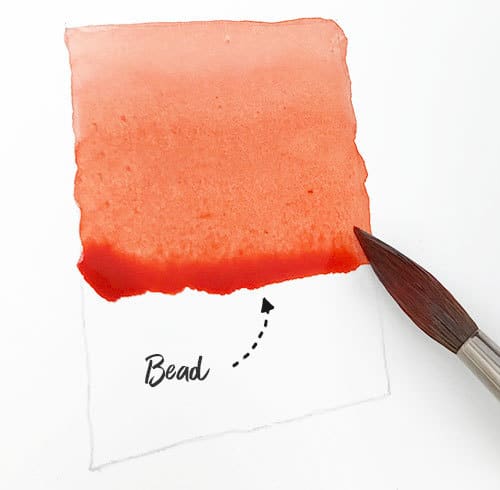
Use a brush which is large plenty for the surface area your painting. For example a number 8 round bush is fine for small work merely bigger washes will probably benefit from a 1" flat castor.
Making sure your launder is moisture enough to course a bead and working apace should eliminate streaks.
Hard edged marks
This is another mistake which, equally yous can judge, they occur when y'all give the wash time to dry between strokes. If paint dries unevenly information technology can create unintentional edges.
If you desire smooth results endeavour to work fast earlier an surface area of paint has time to start drying.
Don't' endeavor to soften an edge that has already dried. This will just atomic number 82 to overworking.
Thick pigment
If your paint is also thick and the pigment is too glutinous it tends to spread unevenly creating streaks or blotches.
When mixing your paint begin by making a pool of water. Then pick up some color with a moist brush and mix into the articulate water. Keep adding paint in this way until you reach the consistency you're looking for. This style you lot get a smoothen launder of paint.
Blooms and backruns
These are some other mutual problem. You have probably experienced these dark feathery patterns that are created when wet paint is introduced to a drier settling launder.
A damp area will draw fluid from an bordering area of greater wetness which so produces these unwanted menstruation marks. This will happen for instance at the finish of your wash if you lot leave a bead of paint. To avoid this you tin can absorb the backlog bead of fluid using a blotted castor.
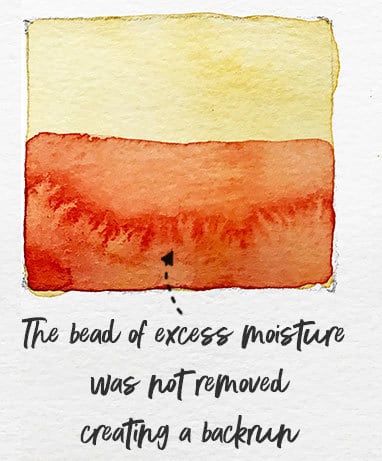
In general, to fix this kind of problem, e'er remove any excess paint before a backrun has fourth dimension to class.
Glazing over a damp wash
I get it.
You're impatient to acquit on with your painting. You can't await to come across the finish result. If you're laying glazes then the temptation is to commencement painting a new layer before the underlying paint is completely dry.
This error can cause backruns and blooms and tin ruin your offset glazing layer.
If you are adding colors on pinnacle of each other and building up your watercolor in layers and then the correct technique is glazing. This modifies the value and hue of whatever initial washes. The secret to glazing is to apply your first launder with a quick and decisive brush stroke. Permit the paint dry out completely then employ your next color without fussing. In this way you obtain vibrant colors.
Simply if yous really can't stand the waiting, you tin can always employ a hair dryer… So long as you lot keep it on a depression heat setting !
Watercolor paper blotches and blemishes
Ever seen foreign bodies floating around in your washes ?
Grit and hair can be a real nuisance for watercolor artists. Even touching the paper too much can leave greasy fingerprints which alter the flow of paint. To avoid this inconvenience make sure you store your paper correctly and go on your piece of work surface complimentary from dust.
Occasionally you get unexpected blotches when laying a wash of color. All watercolor newspaper is treated with sizing which alters the absorbency of the paper. If the coating of sizing is irregular you lot tin get spots on the paper where watercolors are more or less captivated by the paper surface.
To avert this a lot of watercolorists prep their newspaper by brushing the sheet with a clean brush loaded with articulate water. This smooths out any inconsistencies in the surface sizing and avoids blotchy washes.
Dry brush bug
If you're having problems with your dry castor technique it'southward not a surprise.
Information technology requires quite a chip of skill and do to become it right.
To start with, make sure yous're using your brush correctly. If you lot're using a round brush make sure yous utilise the side of the brush not the tip. Personally I find that a flat brush gives the best results. Fan brushes as well work well for this technique. You too need to motility your brush rapidly across the paper. The speed of your brush effects the resulting dry brush texture.
Most of the time problems with dry out brushing arise because of badly judged levels of wetness - wetness of the brush or wetness of the paper.

The amount of paint loaded on your brush needs to be only right. As the name of this technique suggests, your brush should be dry. If you're brush is likewise wet, you'll end upwardly painting a launder. Too dry and the effect is lost. Similarly if your brush hits a damp area on the paper, the pigment blends and forms a wash.
Exercise makes perfect with this technique then grab some scrap newspaper and get brushing !
How to mix brilliant secondary watercolors
I won't go into detail nigh color mixing theory in this postal service, (you'll observe a more comprehensive article here) but a fairly mutual problem is how to mix bright and vivid secondary and tertiary colors. If y'all've tried to mix a bright light-green or a bright regal and been disappointed with the results, here is the reason.
As you know, the basis of colour mixing is master colors. In theory all other colors can be produced from just 3 main colors. Only it'south impossible to notice pure red, yellow, and blue watercolor paints with which y'all tin can mix vivid secondary colors.
This is because primary paints all have a colour bias which is either warm or cold. For instance scarlet can contain a hint of yellowish, or blue can contain hint of red.
The solution is to use a set of both warm and a cool primary colors, (six colors).
The color wheel below shows how these warm and cool primaries should be mixed to effectively produce brilliant secondary colors.
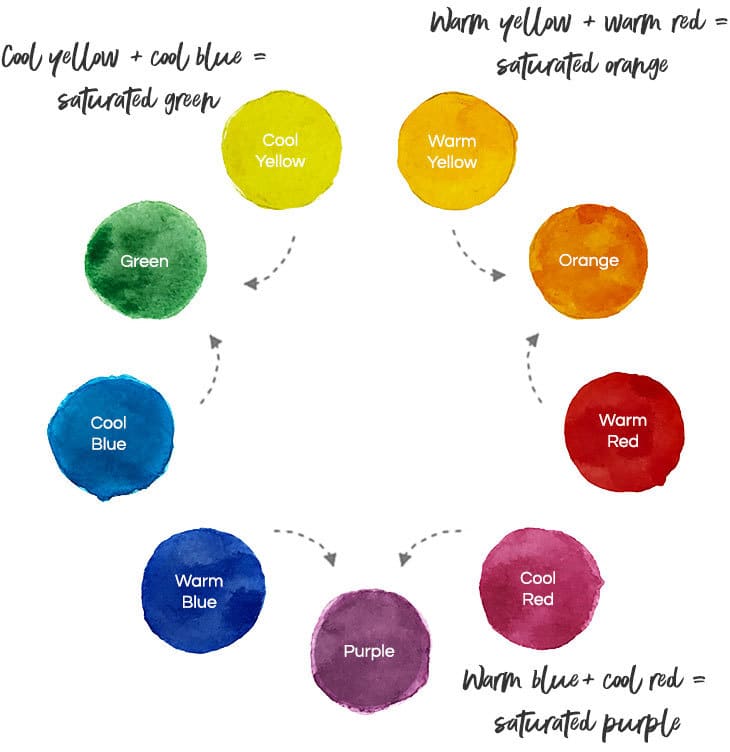
How to avoid muddy watercolors
Nosotros've all been in that location !
Yous've mixed a few pigments together and the resulting colour looks slow and murky. This is what watercolor artists frequently refer to every bit mud.
Most of the time this is because of a characteristic of watercolor paint known as transparency. Paints are usually classified as transparent, semi-transparent or opaque.
The more opaque your paints are, the muddier your colors will be. Mixing with transparent paints is a smashing style to avert muddy watercolors.
The aforementioned problem ofttimes appears when you mix several paints containing more than one paint. The resulting colors are less vibrant. Not all watercolors are single pigment paints.
Information technology's good practice to go into the habit of reading your labels and check the transparency rating and the number of pigments, (If you tin't find this on the paint label then consult the brand's website for a color chart). I normally simply go for transparent paints or at worst semi-transparent, and as far every bit possible single pigment paints. It'southward not e'er easy to find colors that match all these criteria merely information technology's worth the effort. If yous demand aid finding a good palette of transparent, single pigment watercolors y'all can check out my list of recommended paints here…
Some other reason muddy colors appear is when you try to add some other color on top of an existing damp layer (run into overworking beneath). To avoid this, you should only paint onto a wash which is completely dry out (using a glazing technique) or still very moisture (using a charging technique).
Watercolor granulation problems
Granulation is some other property of watercolor paints that you lot demand to exist aware of.
Some paints are granulating and others are not.
For some artists granulation is a trouble.
Granulation is a quality that is very appreciated by some watercolorists because it adds interesting texture to your artwork. Simply for those who adopt shine uniform washes, granulating paints are best avoided.
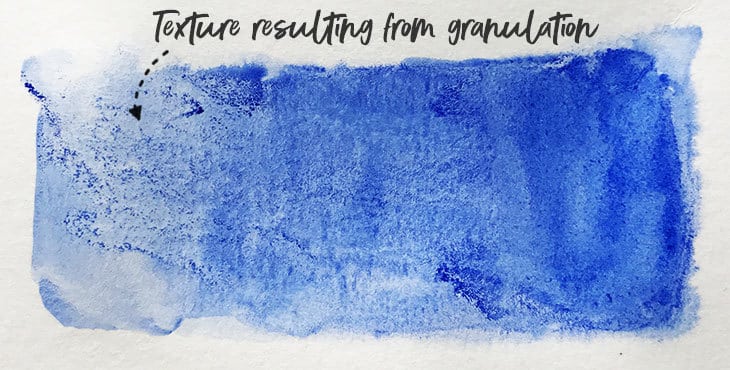
Check the granulating characteristics of your paint if want to avoid the texture effects created by these kind of watercolors.
Staining watercolors
This is another attribute of watercolor paints which you can check by looking at your pigment labels or a manufacturer's color nautical chart. Staining (sometimes referred to equally permanency) indicates how well a pigment adheres to the surface of the paper.
A not-staining pigment is like shooting fish in a barrel to lift off the paper even when it dries. But a heavily staining watercolor will tint the paper durably and is hard to correct.
Staining tin can be a adept or bad matter… And in some circumstances it they can cause frustration.
A paint which is very not-staining is like shooting fish in a barrel to correct because you lot can lift pigments off the paper even when the paint is dry. All the same, working with this kind of paint tin can be very frustrating considering the pigments constantly motility effectually and don't adhere well to your newspaper.
At the other terminate of the scale, a very staining pigment is difficult to remove once the paint is dry. It will stain the newspaper durably (and probably your mixing palette and brushes every bit well).
Of form these are two extremes and the staining ability of watercolors varies from paint to paint.
To avoid the setbacks created by staining get to know your paints ameliorate.
Overworking watercolor
Watercolor is a medium which encourages playing. We constantly experience the need to push the paint around while it's wet, to fight a backrun of water or to polish out the discrepancies of a flat wash. So inevitably nosotros apply more paint or water to adjust a colour and end up repeatedly brushing the moisture paper.
Continuously reworking an area of a painting produces overworking. The resulting paint can await tedious and lifeless.
When you castor the surface of watercolor paper time later time this unravels the paper fibers producing a fuzzy surface texture and pushes the pigments deeper into the newspaper. The result is boring colors.
The solution is to piece of work quickly. When yous paint try to use fast and confident brushstrokes and allow them dry between glazes.
You can exam the difference for yourself by doing a quick experiment. With a flat brush paint a single brush stroke of colour and let it dry. Next to this, paint another brush stroke but this time proceed to repeatedly stroke and blend with your brush as the paint dries.
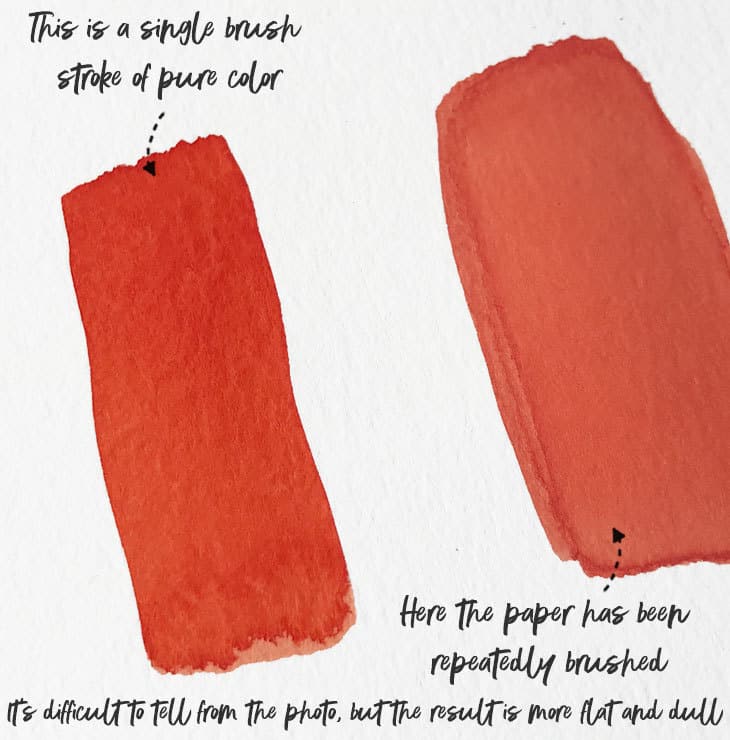
Y'all should see a pregnant difference in the brightness of the dried watercolor.
Overworking is a trouble resulting from attributes of the paper. If you lot find it hard to avoid repetitive strokes you tin try prepping your watercolor paper beforehand with a diluted coating of gum arabic.
This treatment seals the paper surface and helps forestall roughening of the surface texture.
Working from light to dark
The transparent nature of watercolors allows y'all to build up color intensity with several layers of pigment. Every bit a general rule watercolorists begin with light tones and progress to dark.
Unlike other mediums if you beginning by applying dark intense colors, it's difficult, and sometimes impossible to recover lighter values.
So as a dominion of thumb, and specially if you're uncertain almost the terminal appearance of your painting, kickoff with low-cal values. Watercolor should exist built up using light tones get-go and reserving white areas if necessary.
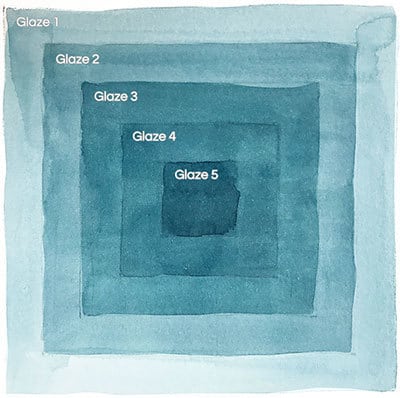
Some other solution is to begin a project by doing a tonal study of your subject. This gives you a better thought of the concluding values you'll be painting.
Correcting colors
Have y'all ever laid down a wash and been disappointed with the last appearance ?
Judging the right hue and tone can exist tricky with watercolors, peculiarly because the pigment dries lighter than when information technology'southward wet.
The technique of glazing helps us suit colors. If yous demand a deeper, more intense color then simply add an additional layer of paint.
Alternatively, if a color seems too bright you can tone it downward by glazing with a complementary color.
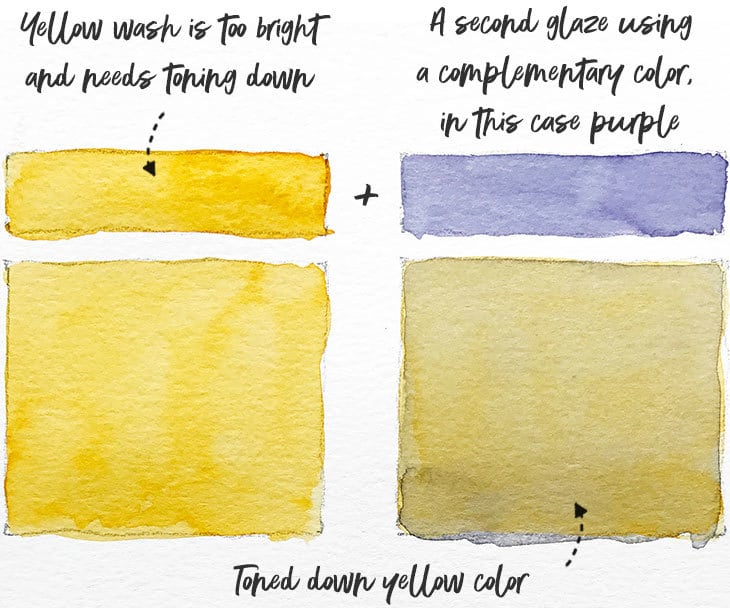
If the tone of your colors appears too nighttime you tin try lifting some of the pigment from the paper. Moisture the whole expanse with clear water and let it sit down for a while. Use a make clean tissue to absorb the moisture and lift some of the color off your painting.
Control the amount of water on your castor
It's very rare to paint with watercolors using a fully loaded soaking wet brush.
Wrinkled paper
It'due south a frustrating problem.
If your paper gets very wet or you lot lay down heavy washes when painting, inevitably it starts to buckle and warp, forming hills and valleys on the surface. This might non seem and so bothersome, merely when new layers of paint start to sink into the lower bumps on your wrinkled paper you start to lose control over your painting.
There are two classic solutions to this dilemma.
The outset is to prep your watercolor paper by stretching it. The procedure involves soaking newspaper so that it expands, then fixing information technology onto a support before it dries. The paper will contract when dry leaving a drum-like surface which no longer warps during painting. For more than data, I've written a complete article virtually stretching paper which you'll find here…
The second quick solution is to utilize thicker newspaper. Watercolor paper exists in various thicknesses, classified past weight. For everyday painting most artists use medium thickness paper which has a weight of 300 gsm / 140 lb. But you tin can also detect thick paper at 640 gsm / 300 lb. This is almost like a board and is much less susceptible to warping.
Apparently you need to utilize watercolor newspaper for your paintings. Ordinary or poor quality paper is not designed to handle water based paints. Information technology volition wrinkle horribly and doesn't have the correct degree of absorbency. Standard paper will suck paint deep into the paper and the result is very dull colors.
How to gear up watercolor mistakes
Ok... Then information technology's not looking proficient…
You've messed up and you really wish you could go dorsum and do a part of your painting again.
All is not lost ! Nosotros tend to think that watercolor paints are hard to correct, only there are a few ways you can recover errors in your paintings.
So before yous tear upward your painting and throw it away, have a look at some of your options below...
Lifting watercolor
Lifting is the procedure of removing paint from an area of paint on your painting.
The ease of lifting dry watercolors depends by and large on how staining the paint is, and to a certain extent, the type of paper used. This procedure is too sometimes referred to as scrubbing.
Lifting is not just a technique for correcting mistakes. It tin can likewise be used while paint is yet wet to adjust the tone of an area of pigment. You can use a clean moist castor to absorb and area of wet pigment. Your castor should have a low liquid content so that it wicks up the paint from the paper surface. Alternatively you can use a clean sponge or tissue to lift color off a larger expanse.
You lot can too apply lifting later the paint has dried. Dampen the surface area that you want to correct. Use a practiced amount of water so that the area remains moisture while you work, you don't desire it to dry out and cause unintentional watermarks. As described in a higher place, use a brush, sponge or tissue to absorb the paint.
Be careful if using a brush. If you repeatedly run a castor back and along you'll start displacing pigments on the paper and end up creating lines in your wash.
How to embrace up watercolor mistakes
Yeah… I admit it. Sometimes you merely demand to beginning afresh.
If yous recall a part of your artwork needs repainting you can rescue a watercolor painting using watercolor footing.
I've used this before to bear on up parts of a painting and it works pretty well.
Yous can become ground from various manufacturers including QOR, Gilt and Daniel Smith. Look closely at the blazon of ground yous buy because some accept a texture upshot which adds additional roughness to the paper surface.
I've used Daniel Smith Titanium White Watercolor Ground before and it lays down smoothly and matches white cotton watercolor newspaper very well.
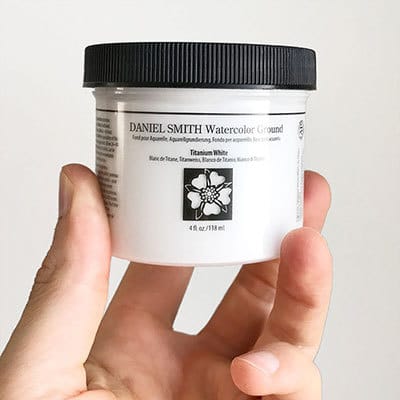
How to recover highlights
With watercolor painting, whites need to exist reserved, since it's the newspaper which provides a white appearance. This is not always easy and occasionally at the terminate of a project you need to add highlights back to your subject.
Y'all can use white gouache to recover highlights. Yous tin also effort white watercolor paint which has a high level of opacity.
Tin you erase watercolor ?
Nosotros've already discussed lifting watercolor off paper. Only erasing watercolor no matter what the paint's staining properties requires a different solution.
Traditionally, for small-scale corrections, artists tend to utilize a scraping tool such every bit a razor blade.
In contempo times a lot of articles talk most using a Mr. Clean Magic Eraser. This white cream like fabric has go popular among watercolor artists for removing paint and fixing errors.
You simply wet the eraser, rinse, then rub the offending part of your artwork.
The advantage is you tin can cut the foam into pocket-size pieces making information technology easier to handle and good for smaller adjustments.
Exist careful with these methods because excessive rubbing will disintegrate your newspaper (known as watercolor pilling). Scraping the paper also tends to remove the coating of sizing on the newspaper which will alter the handling and assimilation of the surface.
Tin you erase pencil from watercolor ?
One time you have covered pencil marks with paint, erasing the lines becomes difficult, especially if the paint is very staining, which seems to set the pencil marks on the paper.
A lot of artists merely leave the pencil marks in place accepting them as role of the artwork.
Merely if y'all're bothered by pencil marks you lot should make certain you only describe thin pencil lines which unremarkably disappear beneath the paint.
I normally utilise a kneaded eraser to half-erase the graphite lines so that they are not likewise obvious.
Another option you can try is to sketch using a watercolor crayon. I've heard of artists using these soluble pencils with some success since they blend more than with the paint as you apply watercolor washes.
Decision
We all slip upward from time to time.
But the affair I love most watercolors is that "mistakes" can sometimes look really good ! Imperfections and unique textures add expression and charm to watercolor paintings.
So don't worry if you lot finish up with unintended paint marks or haphazard patterns… information technology's all part of the dazzler of watercolors !

Source: https://www.watercoloraffair.com/20-ways-to-fix-watercolor-mistakes/

0 Response to "How To Remove Watercolor Paint"
Post a Comment